Framework Design: Lean Implementation in Supply Chain Management
VerifiedAdded on 2023/06/10
|69
|15990
|466
Thesis and Dissertation
AI Summary
This dissertation explores the application of lean manufacturing techniques to improve supply chain management systems within business organizations, particularly focusing on Breezemount, where 50 employees and 2 managers were surveyed and interviewed. It addresses the challenges faced by organizations in effectively managing their supply chains, leading to potential losses and inefficiencies. The research aims to provide practical suggestions for managing the supply chain more effectively, enabling companies to achieve their goals efficiently, improve financial stability, and optimize product distribution. The study includes a literature review covering supply chain history, current issues, and the importance of lean principles, alongside an analysis of waste reduction strategies and the future of lean in supply chain management. The dissertation also proposes a framework for implementing lean principles in supply chain management and discusses the research methodology employed, including questionnaires and interviews, followed by a data analysis and ethical considerations.
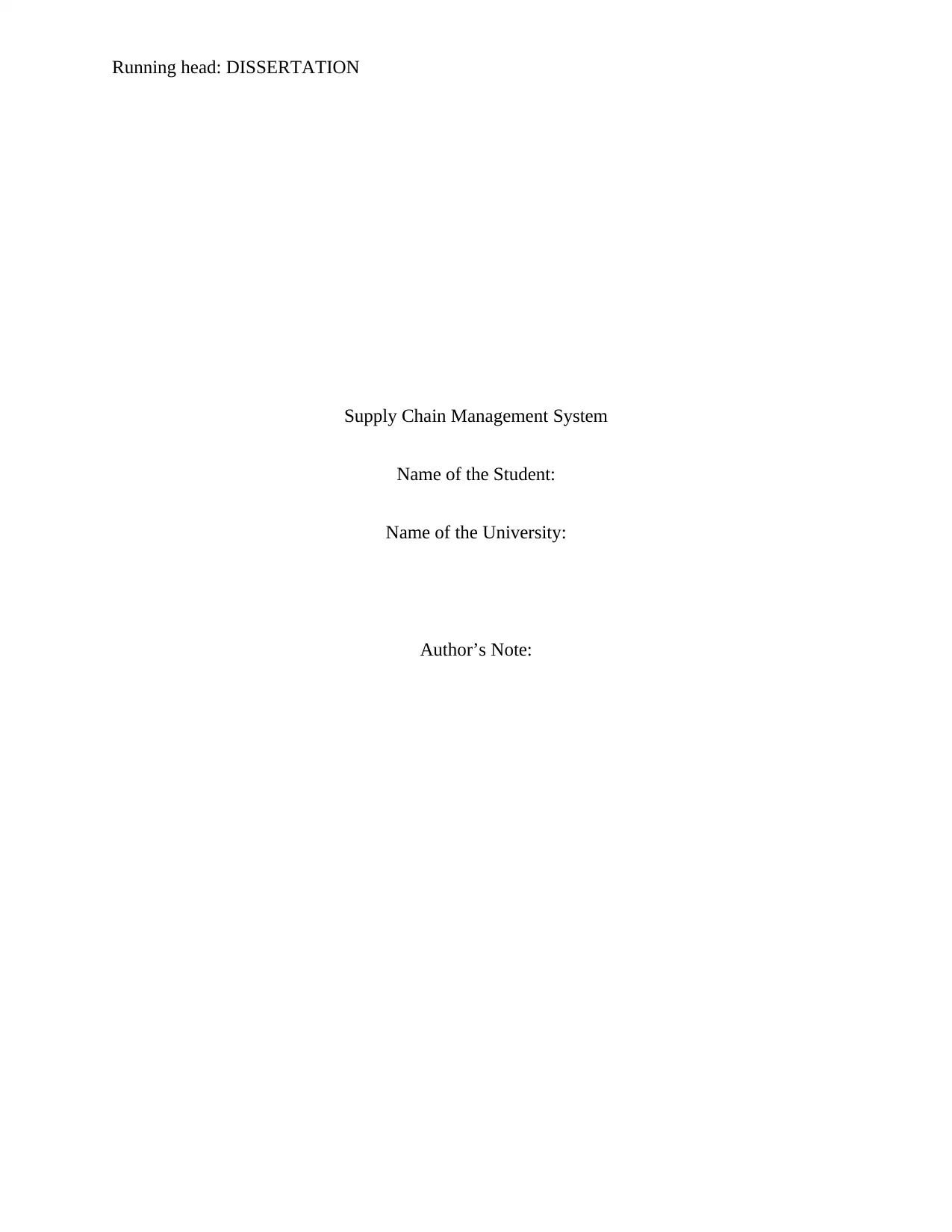
Running head: DISSERTATION
Supply Chain Management System
Name of the Student:
Name of the University:
Author’s Note:
Supply Chain Management System
Name of the Student:
Name of the University:
Author’s Note:
Paraphrase This Document
Need a fresh take? Get an instant paraphrase of this document with our AI Paraphraser

1DISSERTATION
Acknowledgement
Thank you to all of those who have helped listened and encouraged me throughout this study. I
am indebted to my supervisor ……………………. whose guidance, advice and patience have
been immeasurable. My sincere thanks to all members of the…………… [Mention your
university/college name], both staff and students, whose continuous support have made this
thesis possible.
I would like to thank all of the participants in the study: students, teachers and Local Education
Authorities, for the time and help given throughout. Without their participation, this research
would not have been possible. In this context, I am also thankful to them, whose research work
helped me to execute this paper well.
Finally, I thank my family, without whom this thesis would not have been started or completed!
Your encouragement and support have never faltered; thank you.
Acknowledgement
Thank you to all of those who have helped listened and encouraged me throughout this study. I
am indebted to my supervisor ……………………. whose guidance, advice and patience have
been immeasurable. My sincere thanks to all members of the…………… [Mention your
university/college name], both staff and students, whose continuous support have made this
thesis possible.
I would like to thank all of the participants in the study: students, teachers and Local Education
Authorities, for the time and help given throughout. Without their participation, this research
would not have been possible. In this context, I am also thankful to them, whose research work
helped me to execute this paper well.
Finally, I thank my family, without whom this thesis would not have been started or completed!
Your encouragement and support have never faltered; thank you.
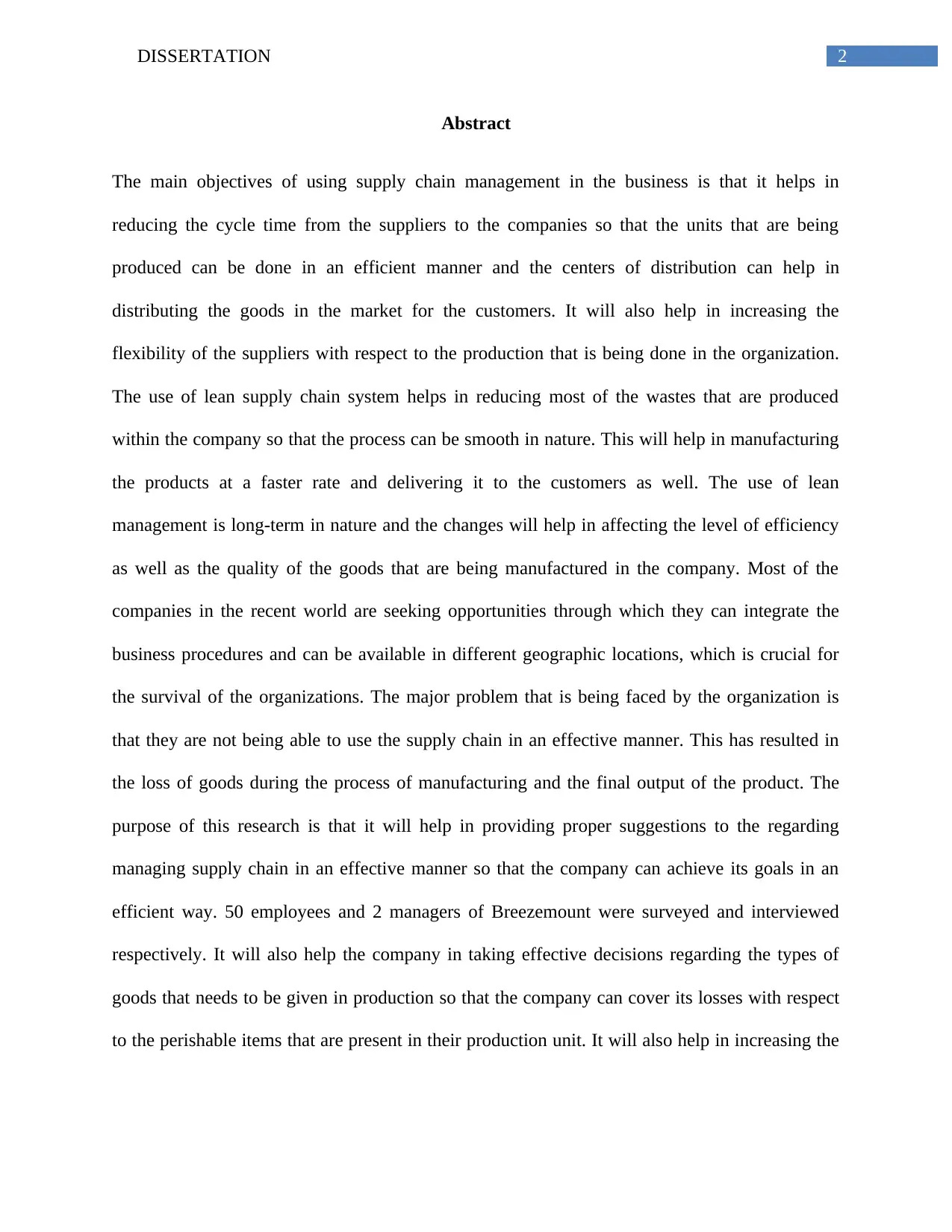
2DISSERTATION
Abstract
The main objectives of using supply chain management in the business is that it helps in
reducing the cycle time from the suppliers to the companies so that the units that are being
produced can be done in an efficient manner and the centers of distribution can help in
distributing the goods in the market for the customers. It will also help in increasing the
flexibility of the suppliers with respect to the production that is being done in the organization.
The use of lean supply chain system helps in reducing most of the wastes that are produced
within the company so that the process can be smooth in nature. This will help in manufacturing
the products at a faster rate and delivering it to the customers as well. The use of lean
management is long-term in nature and the changes will help in affecting the level of efficiency
as well as the quality of the goods that are being manufactured in the company. Most of the
companies in the recent world are seeking opportunities through which they can integrate the
business procedures and can be available in different geographic locations, which is crucial for
the survival of the organizations. The major problem that is being faced by the organization is
that they are not being able to use the supply chain in an effective manner. This has resulted in
the loss of goods during the process of manufacturing and the final output of the product. The
purpose of this research is that it will help in providing proper suggestions to the regarding
managing supply chain in an effective manner so that the company can achieve its goals in an
efficient way. 50 employees and 2 managers of Breezemount were surveyed and interviewed
respectively. It will also help the company in taking effective decisions regarding the types of
goods that needs to be given in production so that the company can cover its losses with respect
to the perishable items that are present in their production unit. It will also help in increasing the
Abstract
The main objectives of using supply chain management in the business is that it helps in
reducing the cycle time from the suppliers to the companies so that the units that are being
produced can be done in an efficient manner and the centers of distribution can help in
distributing the goods in the market for the customers. It will also help in increasing the
flexibility of the suppliers with respect to the production that is being done in the organization.
The use of lean supply chain system helps in reducing most of the wastes that are produced
within the company so that the process can be smooth in nature. This will help in manufacturing
the products at a faster rate and delivering it to the customers as well. The use of lean
management is long-term in nature and the changes will help in affecting the level of efficiency
as well as the quality of the goods that are being manufactured in the company. Most of the
companies in the recent world are seeking opportunities through which they can integrate the
business procedures and can be available in different geographic locations, which is crucial for
the survival of the organizations. The major problem that is being faced by the organization is
that they are not being able to use the supply chain in an effective manner. This has resulted in
the loss of goods during the process of manufacturing and the final output of the product. The
purpose of this research is that it will help in providing proper suggestions to the regarding
managing supply chain in an effective manner so that the company can achieve its goals in an
efficient way. 50 employees and 2 managers of Breezemount were surveyed and interviewed
respectively. It will also help the company in taking effective decisions regarding the types of
goods that needs to be given in production so that the company can cover its losses with respect
to the perishable items that are present in their production unit. It will also help in increasing the
⊘ This is a preview!⊘
Do you want full access?
Subscribe today to unlock all pages.

Trusted by 1+ million students worldwide

3DISSERTATION
financial stability of the company and increase the distribution of the goods in the market in an
equal manner as well.
financial stability of the company and increase the distribution of the goods in the market in an
equal manner as well.
Paraphrase This Document
Need a fresh take? Get an instant paraphrase of this document with our AI Paraphraser
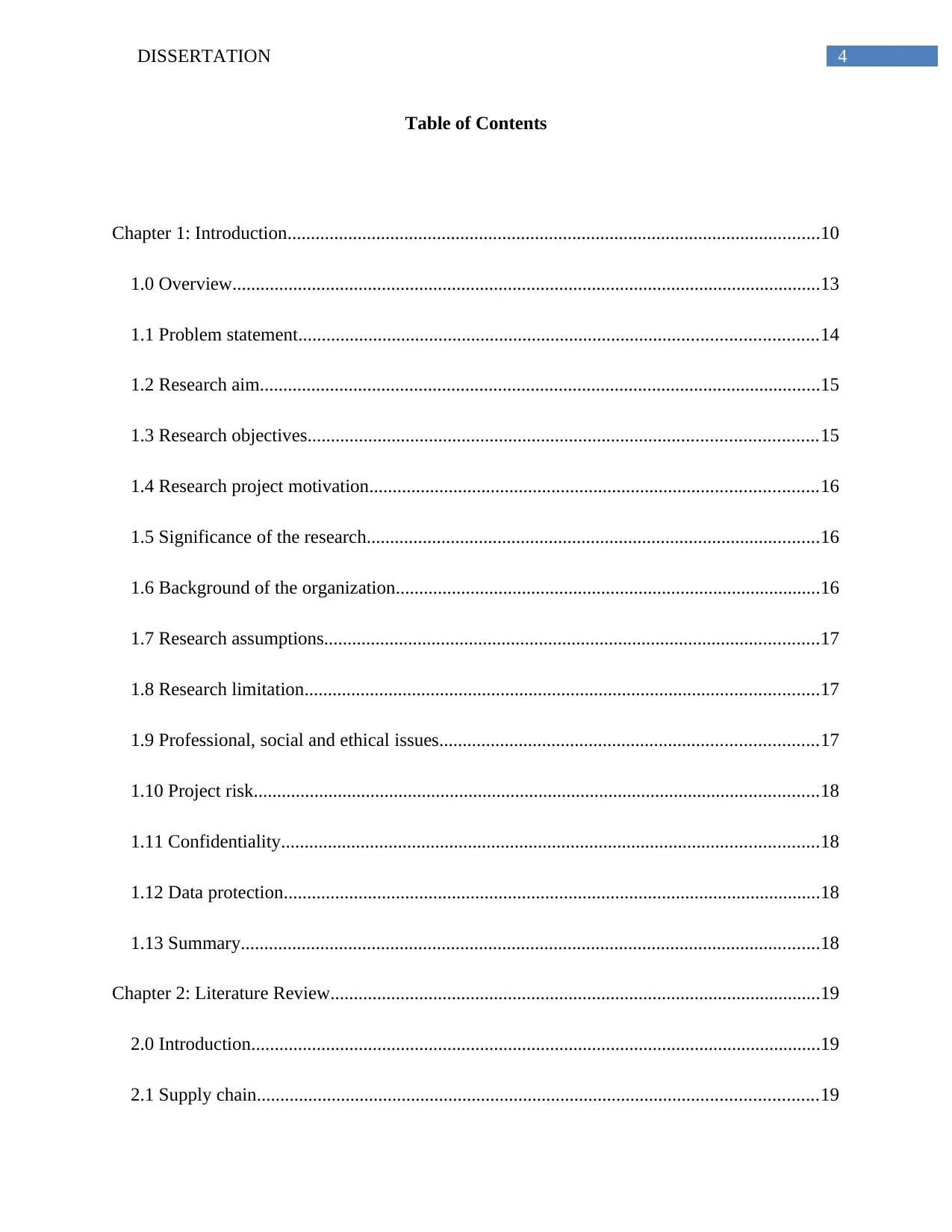
4DISSERTATION
Table of Contents
Chapter 1: Introduction..................................................................................................................10
1.0 Overview..............................................................................................................................13
1.1 Problem statement...............................................................................................................14
1.2 Research aim........................................................................................................................15
1.3 Research objectives.............................................................................................................15
1.4 Research project motivation................................................................................................16
1.5 Significance of the research.................................................................................................16
1.6 Background of the organization...........................................................................................16
1.7 Research assumptions..........................................................................................................17
1.8 Research limitation..............................................................................................................17
1.9 Professional, social and ethical issues.................................................................................17
1.10 Project risk.........................................................................................................................18
1.11 Confidentiality...................................................................................................................18
1.12 Data protection...................................................................................................................18
1.13 Summary............................................................................................................................18
Chapter 2: Literature Review.........................................................................................................19
2.0 Introduction..........................................................................................................................19
2.1 Supply chain........................................................................................................................19
Table of Contents
Chapter 1: Introduction..................................................................................................................10
1.0 Overview..............................................................................................................................13
1.1 Problem statement...............................................................................................................14
1.2 Research aim........................................................................................................................15
1.3 Research objectives.............................................................................................................15
1.4 Research project motivation................................................................................................16
1.5 Significance of the research.................................................................................................16
1.6 Background of the organization...........................................................................................16
1.7 Research assumptions..........................................................................................................17
1.8 Research limitation..............................................................................................................17
1.9 Professional, social and ethical issues.................................................................................17
1.10 Project risk.........................................................................................................................18
1.11 Confidentiality...................................................................................................................18
1.12 Data protection...................................................................................................................18
1.13 Summary............................................................................................................................18
Chapter 2: Literature Review.........................................................................................................19
2.0 Introduction..........................................................................................................................19
2.1 Supply chain........................................................................................................................19

5DISSERTATION
2.2 History of supply chain........................................................................................................20
2.3 Supply Chain Management..................................................................................................22
2.4 Overview of the UK supply chain industry.........................................................................23
2.5 Current issues with supply chain management....................................................................24
2.6 Critical analysis of the causes of the issues with supply chain management......................25
2.7 Critical evaluation of challenges facing the UK supply chain sector..................................27
2.8 Importance of supply chain management............................................................................28
2.9 Advantage of an effective supply chain management in an organization...........................29
2.10 Disadvantage of a non-effective supply chain management in an organization................30
2.11 Implementation of supply chain management in an organization.....................................31
2.12 Summary............................................................................................................................31
Chapter 3: Lean..............................................................................................................................33
3.0 Introduction..........................................................................................................................33
3.1 What is lean?........................................................................................................................33
3.2 History of lean.....................................................................................................................33
3.3 Concept of lean in supply chain...........................................................................................34
3.4 Critical analysis of Lean manufacturing tools and technique..............................................34
3.5 Lean management................................................................................................................34
3.6 Critical analysis principles of lean management.................................................................35
3.7 Critical analysis of emotional intelligence in lean...............................................................35
2.2 History of supply chain........................................................................................................20
2.3 Supply Chain Management..................................................................................................22
2.4 Overview of the UK supply chain industry.........................................................................23
2.5 Current issues with supply chain management....................................................................24
2.6 Critical analysis of the causes of the issues with supply chain management......................25
2.7 Critical evaluation of challenges facing the UK supply chain sector..................................27
2.8 Importance of supply chain management............................................................................28
2.9 Advantage of an effective supply chain management in an organization...........................29
2.10 Disadvantage of a non-effective supply chain management in an organization................30
2.11 Implementation of supply chain management in an organization.....................................31
2.12 Summary............................................................................................................................31
Chapter 3: Lean..............................................................................................................................33
3.0 Introduction..........................................................................................................................33
3.1 What is lean?........................................................................................................................33
3.2 History of lean.....................................................................................................................33
3.3 Concept of lean in supply chain...........................................................................................34
3.4 Critical analysis of Lean manufacturing tools and technique..............................................34
3.5 Lean management................................................................................................................34
3.6 Critical analysis principles of lean management.................................................................35
3.7 Critical analysis of emotional intelligence in lean...............................................................35
⊘ This is a preview!⊘
Do you want full access?
Subscribe today to unlock all pages.

Trusted by 1+ million students worldwide
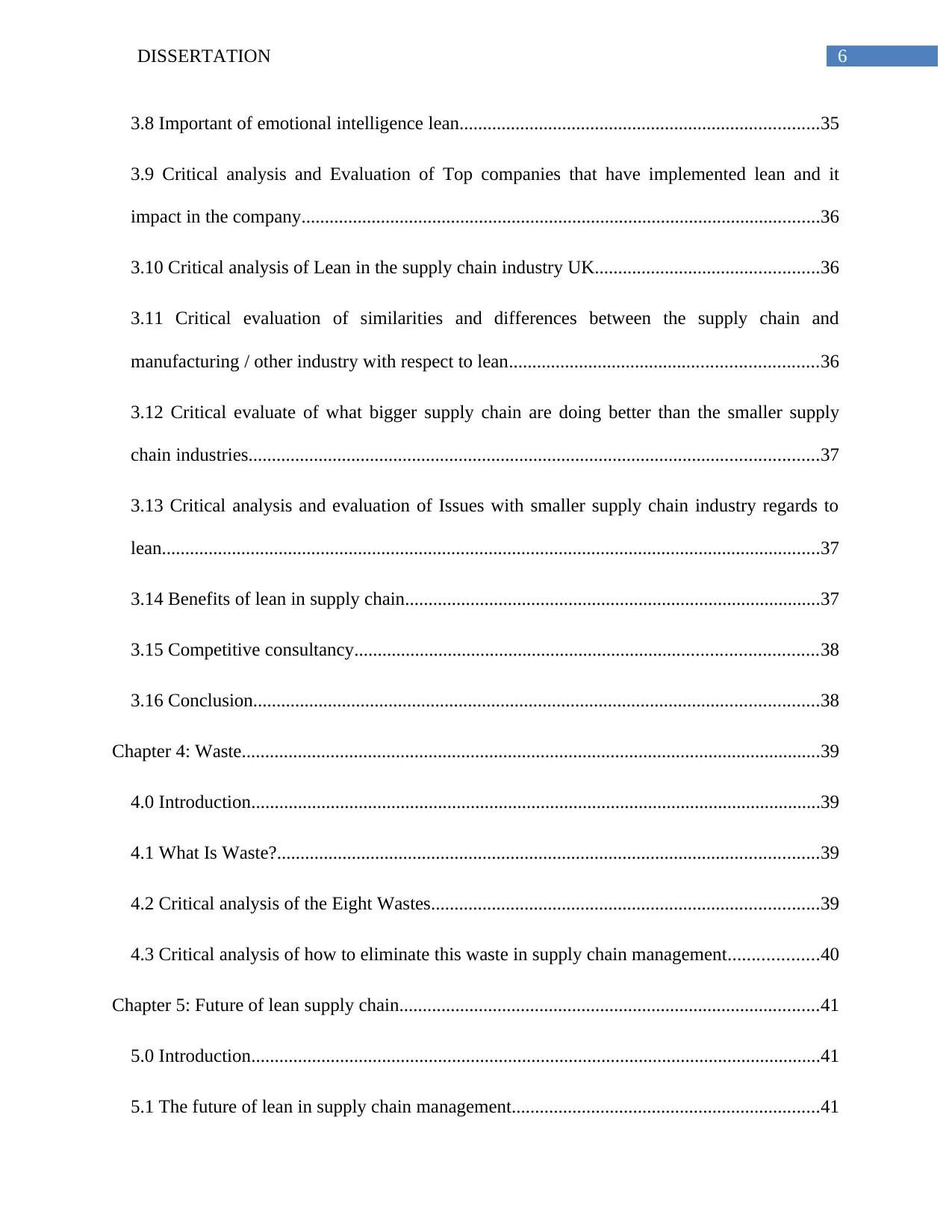
6DISSERTATION
3.8 Important of emotional intelligence lean.............................................................................35
3.9 Critical analysis and Evaluation of Top companies that have implemented lean and it
impact in the company...............................................................................................................36
3.10 Critical analysis of Lean in the supply chain industry UK................................................36
3.11 Critical evaluation of similarities and differences between the supply chain and
manufacturing / other industry with respect to lean..................................................................36
3.12 Critical evaluate of what bigger supply chain are doing better than the smaller supply
chain industries..........................................................................................................................37
3.13 Critical analysis and evaluation of Issues with smaller supply chain industry regards to
lean.............................................................................................................................................37
3.14 Benefits of lean in supply chain.........................................................................................37
3.15 Competitive consultancy...................................................................................................38
3.16 Conclusion.........................................................................................................................38
Chapter 4: Waste............................................................................................................................39
4.0 Introduction..........................................................................................................................39
4.1 What Is Waste?....................................................................................................................39
4.2 Critical analysis of the Eight Wastes...................................................................................39
4.3 Critical analysis of how to eliminate this waste in supply chain management...................40
Chapter 5: Future of lean supply chain..........................................................................................41
5.0 Introduction..........................................................................................................................41
5.1 The future of lean in supply chain management..................................................................41
3.8 Important of emotional intelligence lean.............................................................................35
3.9 Critical analysis and Evaluation of Top companies that have implemented lean and it
impact in the company...............................................................................................................36
3.10 Critical analysis of Lean in the supply chain industry UK................................................36
3.11 Critical evaluation of similarities and differences between the supply chain and
manufacturing / other industry with respect to lean..................................................................36
3.12 Critical evaluate of what bigger supply chain are doing better than the smaller supply
chain industries..........................................................................................................................37
3.13 Critical analysis and evaluation of Issues with smaller supply chain industry regards to
lean.............................................................................................................................................37
3.14 Benefits of lean in supply chain.........................................................................................37
3.15 Competitive consultancy...................................................................................................38
3.16 Conclusion.........................................................................................................................38
Chapter 4: Waste............................................................................................................................39
4.0 Introduction..........................................................................................................................39
4.1 What Is Waste?....................................................................................................................39
4.2 Critical analysis of the Eight Wastes...................................................................................39
4.3 Critical analysis of how to eliminate this waste in supply chain management...................40
Chapter 5: Future of lean supply chain..........................................................................................41
5.0 Introduction..........................................................................................................................41
5.1 The future of lean in supply chain management..................................................................41
Paraphrase This Document
Need a fresh take? Get an instant paraphrase of this document with our AI Paraphraser
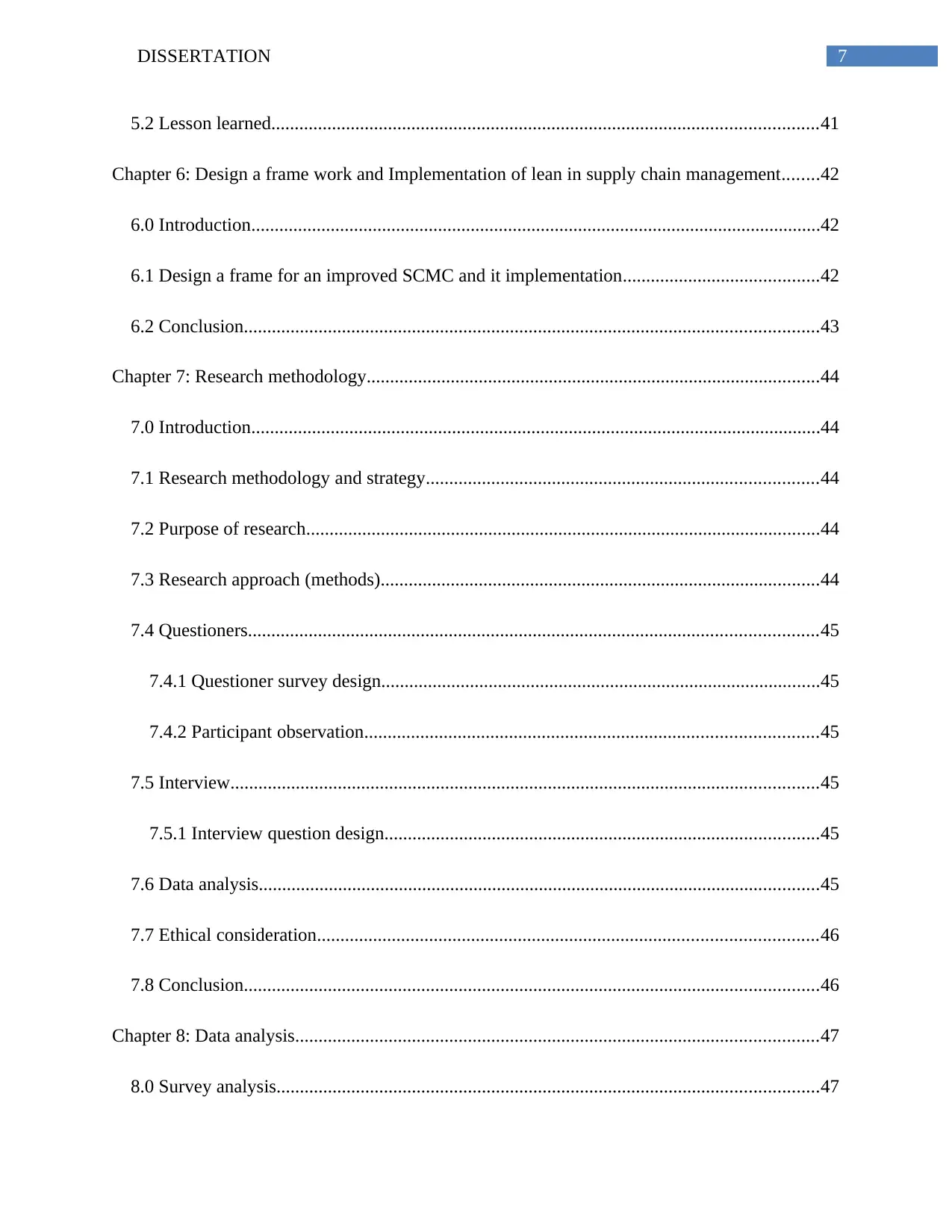
7DISSERTATION
5.2 Lesson learned.....................................................................................................................41
Chapter 6: Design a frame work and Implementation of lean in supply chain management........42
6.0 Introduction..........................................................................................................................42
6.1 Design a frame for an improved SCMC and it implementation..........................................42
6.2 Conclusion...........................................................................................................................43
Chapter 7: Research methodology.................................................................................................44
7.0 Introduction..........................................................................................................................44
7.1 Research methodology and strategy....................................................................................44
7.2 Purpose of research..............................................................................................................44
7.3 Research approach (methods)..............................................................................................44
7.4 Questioners..........................................................................................................................45
7.4.1 Questioner survey design..............................................................................................45
7.4.2 Participant observation.................................................................................................45
7.5 Interview..............................................................................................................................45
7.5.1 Interview question design.............................................................................................45
7.6 Data analysis........................................................................................................................45
7.7 Ethical consideration...........................................................................................................46
7.8 Conclusion...........................................................................................................................46
Chapter 8: Data analysis................................................................................................................47
8.0 Survey analysis....................................................................................................................47
5.2 Lesson learned.....................................................................................................................41
Chapter 6: Design a frame work and Implementation of lean in supply chain management........42
6.0 Introduction..........................................................................................................................42
6.1 Design a frame for an improved SCMC and it implementation..........................................42
6.2 Conclusion...........................................................................................................................43
Chapter 7: Research methodology.................................................................................................44
7.0 Introduction..........................................................................................................................44
7.1 Research methodology and strategy....................................................................................44
7.2 Purpose of research..............................................................................................................44
7.3 Research approach (methods)..............................................................................................44
7.4 Questioners..........................................................................................................................45
7.4.1 Questioner survey design..............................................................................................45
7.4.2 Participant observation.................................................................................................45
7.5 Interview..............................................................................................................................45
7.5.1 Interview question design.............................................................................................45
7.6 Data analysis........................................................................................................................45
7.7 Ethical consideration...........................................................................................................46
7.8 Conclusion...........................................................................................................................46
Chapter 8: Data analysis................................................................................................................47
8.0 Survey analysis....................................................................................................................47

8DISSERTATION
8.1 Interview analysis................................................................................................................53
Reference List................................................................................................................................56
Appendices....................................................................................................................................64
Appendix 1.................................................................................................................................64
Survey questionnaire.............................................................................................................64
Appendix 2.................................................................................................................................66
Interview questionnaire.........................................................................................................66
8.1 Interview analysis................................................................................................................53
Reference List................................................................................................................................56
Appendices....................................................................................................................................64
Appendix 1.................................................................................................................................64
Survey questionnaire.............................................................................................................64
Appendix 2.................................................................................................................................66
Interview questionnaire.........................................................................................................66
⊘ This is a preview!⊘
Do you want full access?
Subscribe today to unlock all pages.

Trusted by 1+ million students worldwide
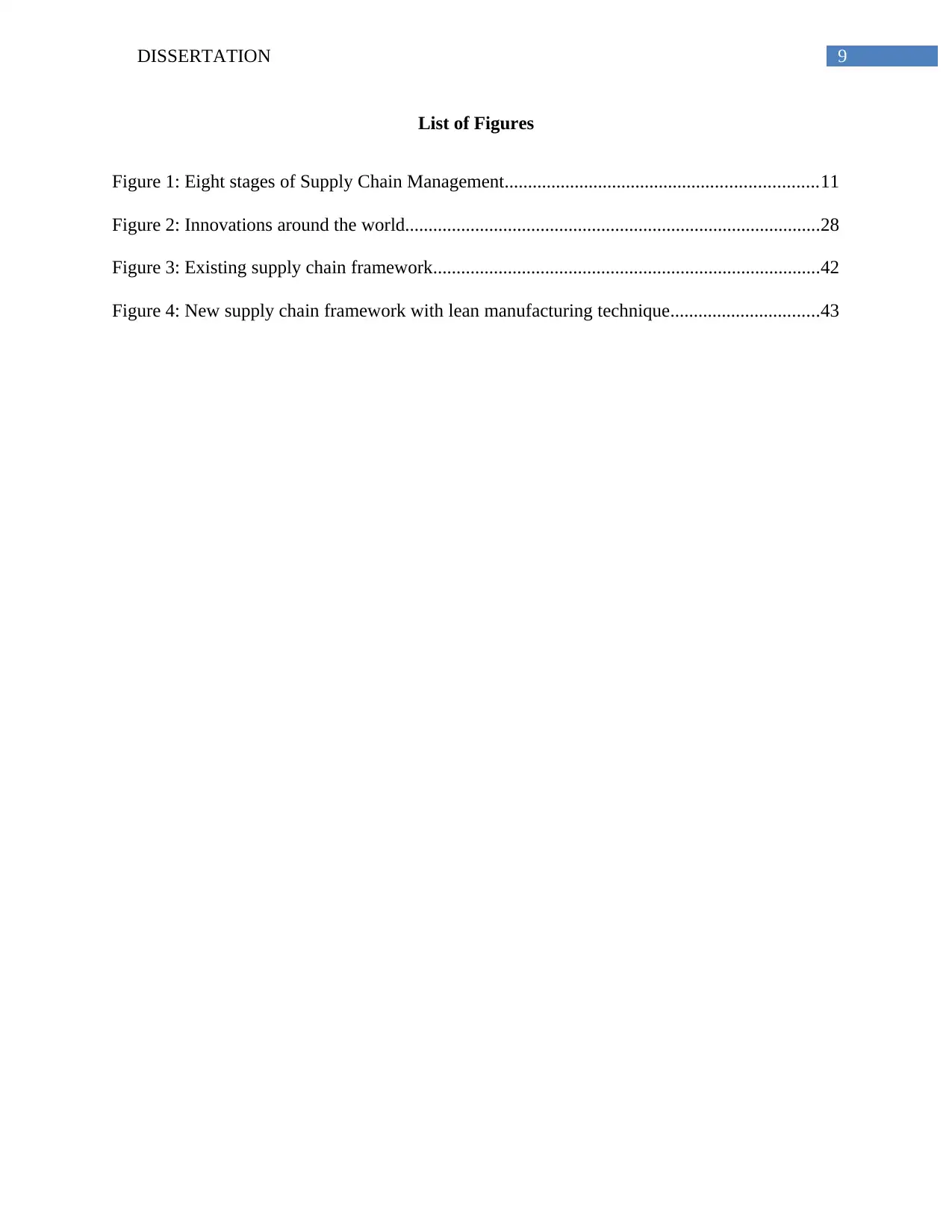
9DISSERTATION
List of Figures
Figure 1: Eight stages of Supply Chain Management...................................................................11
Figure 2: Innovations around the world.........................................................................................28
Figure 3: Existing supply chain framework...................................................................................42
Figure 4: New supply chain framework with lean manufacturing technique................................43
List of Figures
Figure 1: Eight stages of Supply Chain Management...................................................................11
Figure 2: Innovations around the world.........................................................................................28
Figure 3: Existing supply chain framework...................................................................................42
Figure 4: New supply chain framework with lean manufacturing technique................................43
Paraphrase This Document
Need a fresh take? Get an instant paraphrase of this document with our AI Paraphraser

10DISSERTATION
List of Abbreviations
PT = Process Time
WT = Wait Time
INV = Inventory
FTQ = First-time Quality.
List of Abbreviations
PT = Process Time
WT = Wait Time
INV = Inventory
FTQ = First-time Quality.
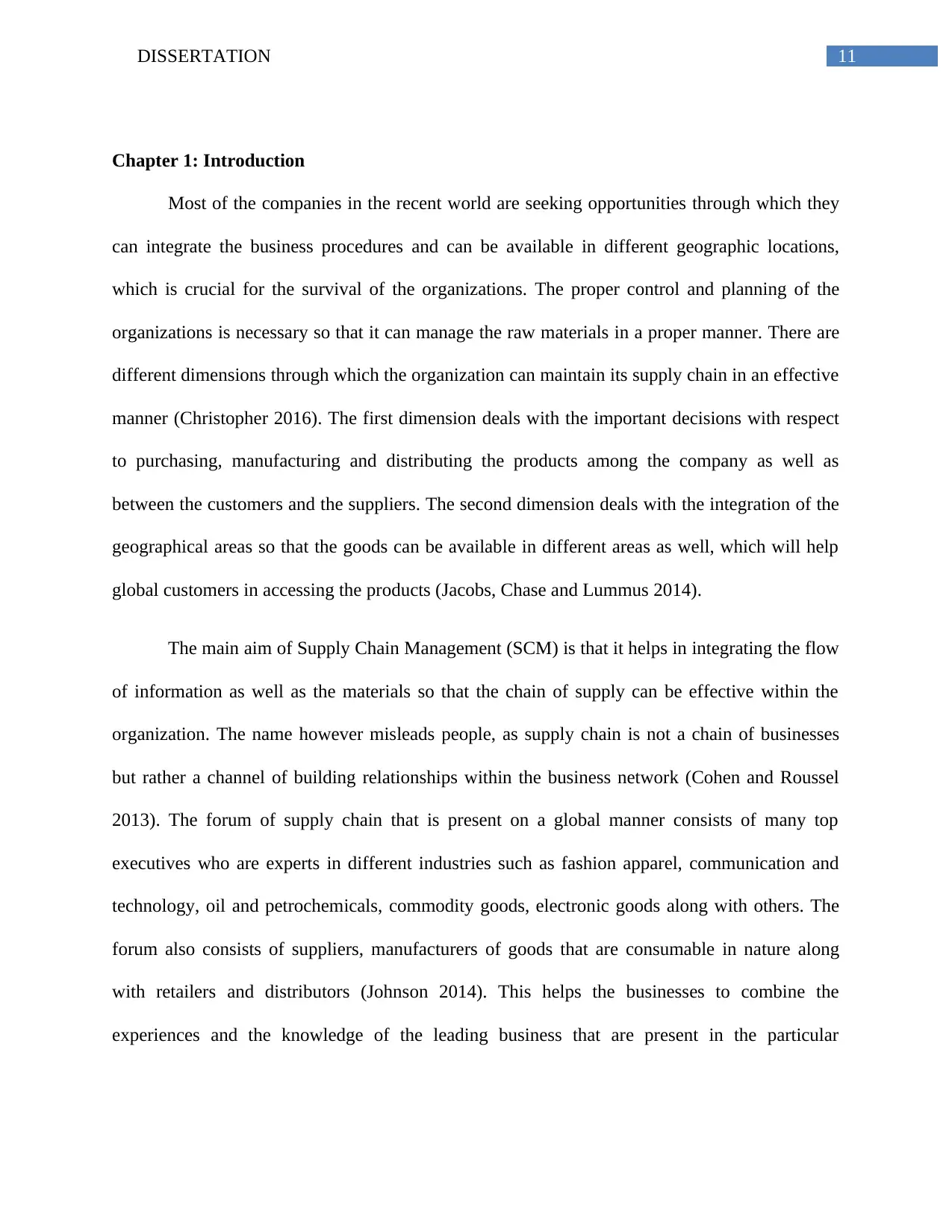
11DISSERTATION
Chapter 1: Introduction
Most of the companies in the recent world are seeking opportunities through which they
can integrate the business procedures and can be available in different geographic locations,
which is crucial for the survival of the organizations. The proper control and planning of the
organizations is necessary so that it can manage the raw materials in a proper manner. There are
different dimensions through which the organization can maintain its supply chain in an effective
manner (Christopher 2016). The first dimension deals with the important decisions with respect
to purchasing, manufacturing and distributing the products among the company as well as
between the customers and the suppliers. The second dimension deals with the integration of the
geographical areas so that the goods can be available in different areas as well, which will help
global customers in accessing the products (Jacobs, Chase and Lummus 2014).
The main aim of Supply Chain Management (SCM) is that it helps in integrating the flow
of information as well as the materials so that the chain of supply can be effective within the
organization. The name however misleads people, as supply chain is not a chain of businesses
but rather a channel of building relationships within the business network (Cohen and Roussel
2013). The forum of supply chain that is present on a global manner consists of many top
executives who are experts in different industries such as fashion apparel, communication and
technology, oil and petrochemicals, commodity goods, electronic goods along with others. The
forum also consists of suppliers, manufacturers of goods that are consumable in nature along
with retailers and distributors (Johnson 2014). This helps the businesses to combine the
experiences and the knowledge of the leading business that are present in the particular
Chapter 1: Introduction
Most of the companies in the recent world are seeking opportunities through which they
can integrate the business procedures and can be available in different geographic locations,
which is crucial for the survival of the organizations. The proper control and planning of the
organizations is necessary so that it can manage the raw materials in a proper manner. There are
different dimensions through which the organization can maintain its supply chain in an effective
manner (Christopher 2016). The first dimension deals with the important decisions with respect
to purchasing, manufacturing and distributing the products among the company as well as
between the customers and the suppliers. The second dimension deals with the integration of the
geographical areas so that the goods can be available in different areas as well, which will help
global customers in accessing the products (Jacobs, Chase and Lummus 2014).
The main aim of Supply Chain Management (SCM) is that it helps in integrating the flow
of information as well as the materials so that the chain of supply can be effective within the
organization. The name however misleads people, as supply chain is not a chain of businesses
but rather a channel of building relationships within the business network (Cohen and Roussel
2013). The forum of supply chain that is present on a global manner consists of many top
executives who are experts in different industries such as fashion apparel, communication and
technology, oil and petrochemicals, commodity goods, electronic goods along with others. The
forum also consists of suppliers, manufacturers of goods that are consumable in nature along
with retailers and distributors (Johnson 2014). This helps the businesses to combine the
experiences and the knowledge of the leading business that are present in the particular
⊘ This is a preview!⊘
Do you want full access?
Subscribe today to unlock all pages.

Trusted by 1+ million students worldwide
1 out of 69
Related Documents
Your All-in-One AI-Powered Toolkit for Academic Success.
+13062052269
info@desklib.com
Available 24*7 on WhatsApp / Email
![[object Object]](/_next/static/media/star-bottom.7253800d.svg)
Unlock your academic potential
Copyright © 2020–2025 A2Z Services. All Rights Reserved. Developed and managed by ZUCOL.




